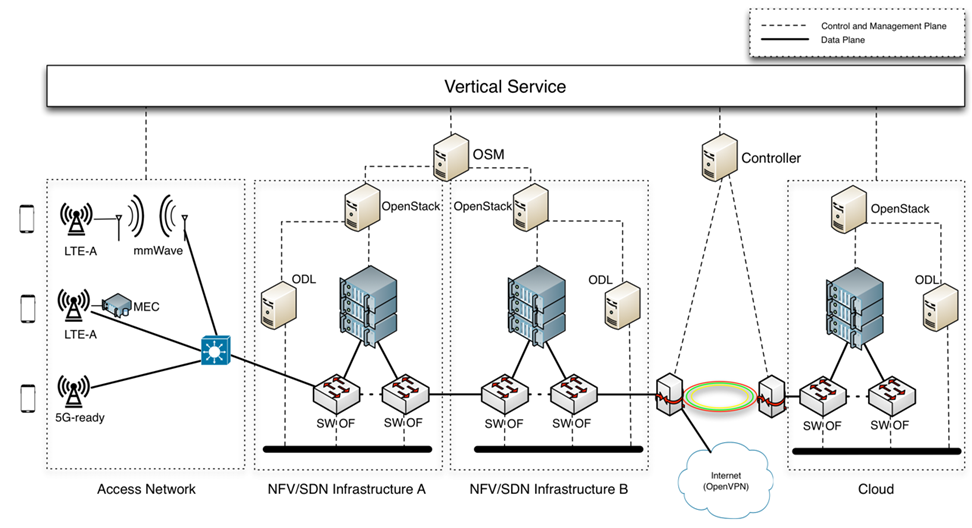Contact: spain-facility@5g-vinni.eu
The 5G-VINNI facility in Spain will be part of the 5TONIC lab (https://www.5tonic.org/). 5TONIC provides an open innovation environment for research in 5G technologies, and their validation by equipment vendors, network service providers, and customers.
The 5TONIC laboratory includes a solid baseline of facilities, infrastructure and equipment to support advanced experimentation in the 5G virtual network function and wireless systems areas. In this respect, the laboratory offers a datacenter with space for 24 racks, including two racks for communications among these racks and with other platforms. 5TONIC provides access to a common infrastructure with specific-purpose hardware, to assist in experiments, trials and demonstrations with particular 5G network technologies, as well as to commodity hardware, which allows a cost-effective approach to configure different network topologies of variable size and capacity.
Summary of capabilities
- Slicing (OSM extension)
- Service Orchestration (OSM NBI)
- NFV MANO (OSM) and NFVI (OpenStack)
- SDN (ODL/ONOS)
- Support for micro-VNFs
- 5G RAN (SDR), low frequencies and 30-300GHz
- Advanced monitoring and data-driven management
- Edge computing (MEC and non-MEC)
- 5G Core (possibly SBA-based)
The 5TONIC lab is already being used to demonstrate a wide range of 5G use cases in direct collaboration with involved verticals, and several of them can be considered as part of the experiments to be run in 5G-VINNI. In particular:
- eHealth (collaborative emergency management). This case considers the monitoring of health parameters by means of smart t-shirts, and a coordinated response of medical emergency teams with the help of registered volunteers.
- Industry 4.0 (edge-enabled robots). This case considers the application of control and/or coordination tasks for a set of cooperating robots, with these tasks running at nodes located at the network edge.
- Tourism (ER-enabled conventions). This case considers the usage of enhance reality environments to facilitate the experience of the attendees of conventions and conferences.
- Emergency recovery (micro-VNFs). This case considers the deployment of micro-VNFs on mobile platforms (drones) to provide a fast and flexible network edge to support access in case of emergencies, and probably other cases related with crowded events in remote locations. The 5TONIC partners are especially interested in experimenting with this use case in the framework of 5G-VINNI
With respect to the access network, the 5TONIC infrastructure includes equipment to support advanced experimentation with 5G-ready equipment, commercial LTE-A base stations implementing different functional splits and Software Defined Radio (SDR) systems. LTE-A equipment will allow the deployment of 3GPP rel. 15 extensions to test early 5G scenarios. The SDR equipment consists of a set of eNodeB with FPGA cards, to run high speed and computationally intensive physical layer operations in WiFi/LTE, radio frequency transceivers and a real-time controller, able to execute MAC and PHY control algorithms with micro-second resolution. Driven by the 5G vision, which considers to extend the use of the radio spectrum, the infrastructure also supports communications in the frequency band between 30Ghz and 300Ghz (mmWave), as well as low frequency communications. In particular, the test-bed includes several scalable SDR platforms, along with a set of 60Ghz down/up-converters, supporting the generation and reception of arbitrary signals in the frequency bands under consideration. 5TONIC provides several end-user terminals to connect to all these access networks: smartphones, USB dongles and LTE-A routers.
The NFV/SDN infrastructure A equipment includes high-power servers to test real deployments, supporting NUMA architecture, and 10Gbps Ethernet optical transceivers with SR-IOV capabilities. These servers are connected between them to deploy the data planes, by using a switching fabric with 10Gbps Ethernet optical ports. To complement this infrastructure, the laboratory provides an NFV/SDN infrastructure B including a set of mini-PC computers with DPDK capabilities, supporting the experimentation with Virtual Network Functions (VNFs) at smaller scale. Infrastructures A and B are interconnected using high-performance OpenFlow switches. Furthermore, the Management and Network Orchestration (MANO) part of the laboratory includes servers connected by 1Gbps Ethernet cards. The MANO stack is provided using OSM Release TWO for the service and network orchestration, OpenStack for the virtual infrastructure management (VIM), and OpenDayLight (ODL) for the SDN enabled part. The different elements of the test-bed can be flexibly interconnected using a pool of low-power single board computers, with Ethernet and WiFi network cards, which can be configured to deploy diverse network functionalities, such as OpenFlow switches, wireless routers, WiFi access points, firewalls or load balancers.
The cloud part of the laboratory is composed of medium-performance servers as compute/storage nodes as well as miniPCs to deploy OpenStack and ODL controllers. Servers are interconnected using OpenFlow switches, using a similar approach as in the SDN/NFV infrastructures. The goal of this system is to deploy servers and/or applications that can be used to perform E2E trials.
To interconnect SDN/NFV infrastructures with the cloud side, the 5TONIC laboratory includes a metro-core network, which is connected to the components described before by means of dedicated gateways. The metro-core network setup is composed of IP/MPLS and optical devices. The core control plane test-bed is composed of GMPLS nodes with internally developed software. The experimental setup is built with a combination of real and emulated nodes. The latter nodes run on Ubuntu Linux servers. Each emulated node implements a GMPLS stack (including RSVP, OSPFv2 and PCEP) and a Flexible Node emulator.
Finally, the Vertical Service layer allows users of 5TONIC to prepare, deploy and analyze their trials. Remote users can connect to this service by using a dedicated OpenVPN.

Architectural components in the Spain facility site


